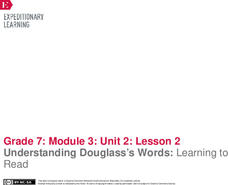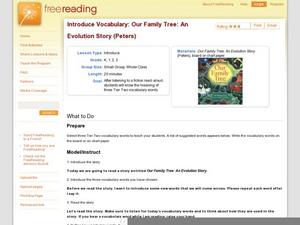Curated OER
Bone Transformations
Students create a picture from the shape of a bone. For this life science and art lesson, students discuss their bones and their purposes, then use a picture of a bone as a starting point for an artistic transformation. Lesson can be...
Curated OER
GET UP, STAND UP: Fighting for Rights Around the World
Students explore basic human rights as they explore music by black artists. In this human rights lesson plan, students examine music as a cultural reflection of the justice issues. Students analyze Jamaican roots reggae of the 70s,...
Curated OER
Mysteries of the Past-An Artistic Expedition
Students explore expression in artwork. In this interdisciplinary lesson, students travel to ancient Egypt to examine abstract art of the Nile River valley through several hands-on activities.
Curated OER
Systems of the Body: Movement and Choreography
Learners create movements that connect art and science. In this body systems lesson, students interpret the function of body systems, organs, and processes as they create movements to exhibit their research findings.
Curated OER
Topic: Persuasive Speech
Students examine what makes a speech persuasive. In this speech lesson, students recognizes what is needed to make a good persuasive speech and create their own persuasive speech about something related to the human body.
Curated OER
Religion and Ethics: Living with Special Needs
Students explore human behavior by exploring mental and physical disabilities. In this learning disability lesson, students identify the different disabilities students have which prevent them from working at the same pace as the rest of...
Curated OER
Life size figures - Moveable Murals
Learners create life-size human figures and decorate them in a collage style with torn colored pieces of pictures from magazines. They display them around the school, creating life-size murals.
Curated OER
Gyotaku Lesson Plan
Students study the Japanese art of fish painting called Gyotaku while examining the lifestyle of Japanese fishermen at the end of the Edo period. They make a Gyotaku fish print and write a haiku poem using the proper number of syllables...
Curated OER
The Curved House - Endless House Project
Young scholars analyze the art and architecture projects of Frederick Kiesler. In this architecture analysis lesson, students read and study images the endless house project. Young scholars complete discussion activities and questions...
Curated OER
Cardboard Weaving
Fifth graders observe artworks of cardboard weaving for their art elements and principles of organization. In this cardboard weaving lesson, student create their own and compare artworks of the past and present. Students self...
Curated OER
American Families
Students research psychology by participating in a role-play activity. In this human relationship lesson, students define the term "family" and read assigned text which discusses how family relationships work. Students answer study...
Curated OER
Importance of Friendship
Students identify child psychology by completing a worksheet regarding friends. In this human relationship lesson, students discuss the characteristics that make a good friend and how to handle conflicts. Students answer study questions...
Curated OER
Writing Exercises: Russian Revolution, #2
Why did communism develop in an unindustrialized Russia? What human rights were violated under Joseph Stalin? And, how did the Soviet Union become industrialized? These are the writing prompts your class will work to answer with complete...
Curated OER
Casting Doubt: "Color-blind" and Nontraditional Casting Decisions
In his article about color-blind casting entitled, "Willy Loman Is Lost, Still Looking for Stimulus Plan and Some Dignity," Charles Isherwood quotes August Wilson as saying, "To mount an all-black production of a 'Death of a...
EngageNY
Understanding Douglass’s Words: Learning to Read
How is a sentence like the human body? Scholars think about the comparison as they view an image of the human anatomy and begin to complete an Anatomy of a Sentence anchor chart. They review roots, prefixes, and suffixes and then begin...
Curated OER
Lesson: Creating a Superhero Sculpture
Indian art depicts an amazing pantheon of gods and goddesses, each having interesting powers and purposes. Young art historians use the provided images to analyze a carved sculpture of a monkey-god. They then brainstorm the attributes...
Curated OER
Portraits in Clay: Elementary Sculpture Lesson
It is lovely how this lesson incorporates the importance or personal expression and art history. Children create low-fire ceramic heads that express emotion or personal feelings. The entire process is laid out step-by-step. All you need...
Teachers.net
How to Write a Movie Review from a Pet's Perspective
When would two paws up denote a blockbuster film in your classroom? Only when young writers create movie reviews from a pet's perspective in this imaginative expository writing practice. This engaging topic begins with a class discussion...
Curated OER
Ballet and Classical Music
Fourth graders explore ballet. In this dance and music humanities lesson, 4th graders practice ballet positions and play a card game using French ballet vocabulary. Students count beats in rhythm patterns and listen to classical music...
Curated OER
Persona in Autobiography
A talkative old man? A naïve believer in Human Perfectibility? A Sage? Who is this guy, anyway? The Autobiography of Benjamin Franklin launches a study of the way Franklin uses structure, style, and purpose, as well as different...
Curated OER
Introduce Vocabulary: Our Family Tree: An Evolution Story (Peters)
Lisa Peters presents macroevolution as a large-scale family tree in her book Our Family Tree: An Evolution Story. She suggests the process from single-celled organisms to modern-day humans, and learners explore new vocabulary...
National Mississippi River Museum & Aquarium
Sun Printing
Ozalid acid paper is sensitive to the light. It reacts by getting darker, and it's the same paper photographers use when they print their pictures. Here, kids get to use photo-sensitive paper to create sun prints to find out...
Maryland Department of Education
The Concept of Diversity in World Literature Lesson 4: Proverbs
"Eneke the bird says since men have learnt to shoot without missing, he has learnt to fly without perching." As part of their study of Things Fall Apart, class members read Paul Hernadi and Francis Steen's essay, "The Tropical Landscapes...
ReadWriteThink
Teaching Point of View With Two Bad Ants
What better way to explain the concept of point of view than from an ant's perspective! After reading Two Bad Ants, pupils identify the point of view of the ants by studying the text and pictures. Then, they fill out a...























